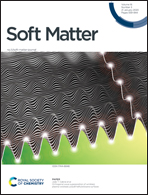A facile method to synthesize strong salt-enhanced hydrogels based on reversible physical interaction†
Abstract
To overcome the adverse effects of salt on the mechanical properties of hydrogels, a facile double cross-linking method has been proposed to synthesize salt-enhanced tough hydrogels. Herein, a poly(hexafluorobutyl methacrylate-acrylamide) hydrogel [P(AAm-co-HFBMA) hydrogel] is prepared by the copolymerization of acrylamide (AAm) and hexafluorobutyl methacrylate (HFBMA) with N,N′-methylene bisacrylamide (NMBA) as a cross-linking agent in a dimethylformamide (DMF)/aqueous solution; DMF is then replaced by water. The results indicate that the tensile fracture stress of the P(AAm-co-HFBMA) hydrogel (20 mol% HFBMA) is as high as 0.43 MPa, which is far better than that of the PAAm hydrogel (ca. 30 kPa). Additionally, with a further increase in the hydrophobic structural units (25 mol% HFBMA), the tensile fracture stress of the P(AAm-co-HFBMA) hydrogel can be increased up to 2.34 MPa. The mechanical strength of the P(AAm-co-HFBMA) hydrogel is significantly enhanced to 3.50 MPa (2 M) from 2.34 MPa (0 M) after it is soaked in aqueous NaCl solutions with various salt concentrations. The mechanical properties and the results of the DSC analysis indicate that the main reason for its mechanical strength to exhibit a unique salt-enhancement trend can be explained as follows. After the P(AAm-co-HFBMA) hydrogel is soaked in the salt solution, the network gradually collapses with the penetration of the small molecules of salt. Thus, the hydrophobic C–F units easily form dynamic cross-linking junctions due to the switchable hydrophobic interaction between C–F groups, which can endow the P(AAm-co-HFBMA) hydrogel with a more effective dynamic energy dissipation mechanism in salt solution.



 Please wait while we load your content...
Please wait while we load your content...